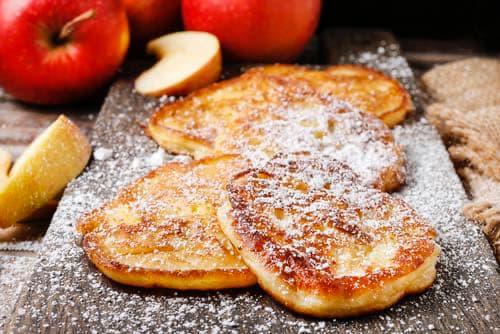- Home
- Renaissance Desserts
- Renaissance Tansie Recipes
Renaissance Tansie Recipes
Renaissance Tansie recipes were quite common and had been popular since earlier medieval times. Tansies are an ancient custard-like pancake dish similar in taste to today's fritters, incorporating rich cream and eggs, and sometimes thickened with dry bread crumbs.
Apple slices were often added to the tansie batter along with lemon juice, but it could also contain other types of fruit, such as raspberries, thin slices of lemon, or even edible flower blossoms. Spinach juice was traditionally used to color the tansie batter green.
Authentic Renaissance Tansie Recipes
The Queen-like Cloſet or Rich Cabinet (1672)
 Homemade Renaissance Tansies With Powdered Sugar
Homemade Renaissance Tansies With Powdered Sugar(Source: ©agneskantaruk/Depositphotos.com)
Tansies are easy to make and taste quite delicious, especially since these Renaissance tansie recipes avoid the bitter taste of the tansy herb. Enjoy a quintessential, historical Easter treat.
To make an Apple Tanſie
Take a Quart of Cream, one Manchet grated, the yolks of ten Eggs, and four Whites, a little Salt, ſome Sugar, and a little Spice, then cut your Apples in round thin ſlices, and lay them into your Frying-Pan in order, your Batter being hot, when your Apples are fried, pour in your Batter, and fry it on the one ſide, then turn it on a Pie-Plate and ſlide it into the Pan again, and fry it, then put it on a Pie-Plate, and ſqueeze the Juice of a Limon over it, and ſtrew on fine Sugar, and ſerve it to the Table.
To make a green Tanſie to fry, or boil over a Pot
Take a quart of Cream, the yolks of one dozen of Eggs and half, their Whites well beat, mix them together, and put in one Nutmeg grated, then colour it well with the Juice of Spinage, and ſweeten it with Sugar; then fry it with Butter as you do the other, and ſerve it in the ſame manner; but you muſt lay thin ſlices of Limon upon this.
If you will not fry it, then butter a Diſh, and pour it therein, and ſet it upon a Pot of boiling water till it be enough; this is the better and eaſier way.
Thus you may make Tanſies of any other things, as Cowſlips, Rasberries, Violets, Marigolds, Gilliflowers, or any ſuch like, and colour them with their Juice; you may uſe green Wheat inſtead of Spinage.
English Tansy Pudding Recipe
With a Saucepan Over the Sea (1902)
Compare this 1902 recipe for tansie pudding to the much older
Renaissance tansie recipes.
Pour 3 tablespoonfuls of the expressed juice of bruised tansy leaves over enough breadcrumbs to absorb it, add 3 ounces of blanched and pounded almonds, 2 ounces of sugar, 2 ounces of butter, 1 teaspoonful of grated lemon peel, 3 beaten eggs, 1/2 pint of cream or milk.
Boil, like a custard, and serve with lemon sauce, hot. This pudding is still eaten in country towns and is considered wholesome in the spring.
About the Renaissance Tansie Recipes
 The Medicinal Herb Tansy, Also Known as Golden Buttons
The Medicinal Herb Tansy, Also Known as Golden Buttons(Source: ©olesia/Depositphotos.com)
In medieval times, tansies were often garnished with bitter-tasting leaves from the herb "tansy," from which they were given their name.
 14th Century Mount Grace Priory Ruins in North Yorkshire
14th Century Mount Grace Priory Ruins in North Yorkshire(Source: ©Don Bell)
Though tansies were traditionally eaten and enjoyed by people the year-round and especially on festive occasions, they were especially popular at Easter in remembrance of the "bitter herbs" of Passover. You won't find a more traditional Easter dish to serve your family.
 Don at Mount Grace Priory, North Yorkshire, England
Don at Mount Grace Priory, North Yorkshire, England(Source: ©Don Bell)
As a supposed side benefit, the tansy herb was thought to control flatulence and prevent intestinal worms after eating large quantities of salted fish during Lent.

Gum Dragon and 23kt edible Gold Leaf are not easy to find locally, so here's where to get the historical ingredients called for in some Renaissance recipes.

Curious about that strange ſ character in words? Wondering about historical ingredients and cooking methods? Go to the Glossary of Renaissance Cooking Terms for help.

Sign Up now for GRANDMA'S DESSERT CLUB and download your FREE PDF COPY of Grandma McIlmoyle's Little Dessert Book. Also receive my regular Bulletin featuring classic recipes and nostalgia.

















